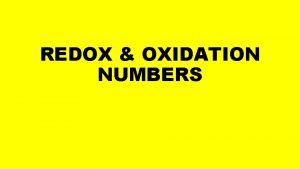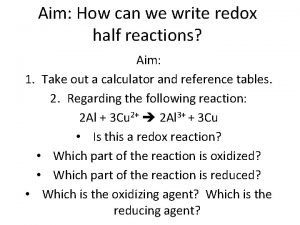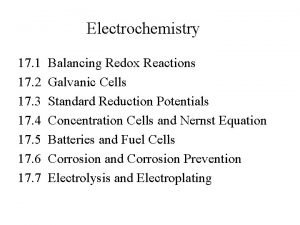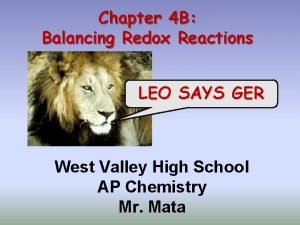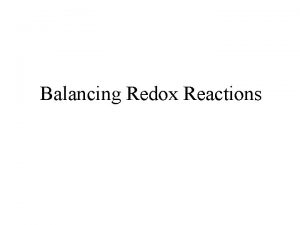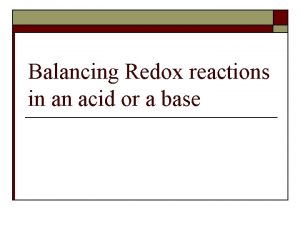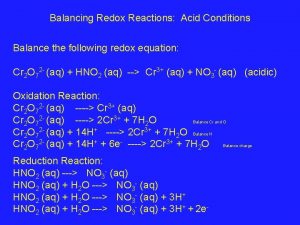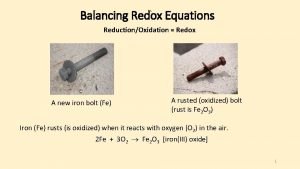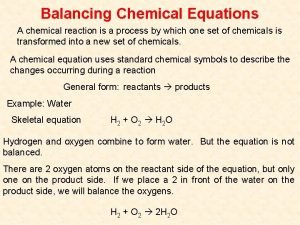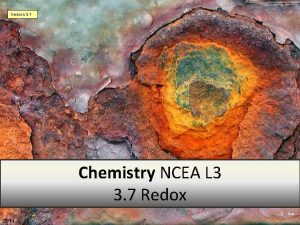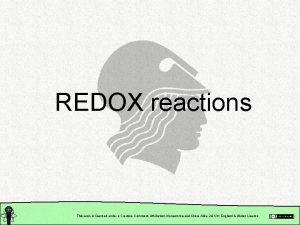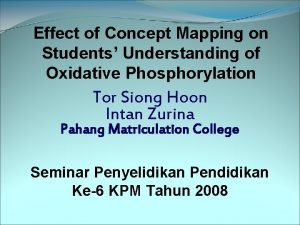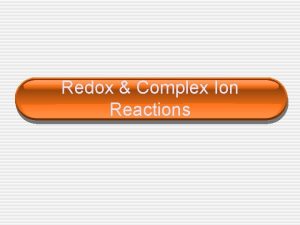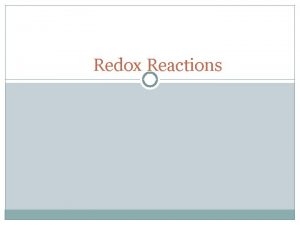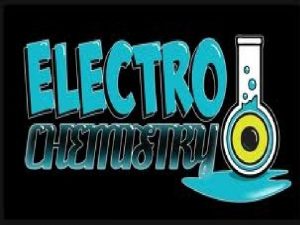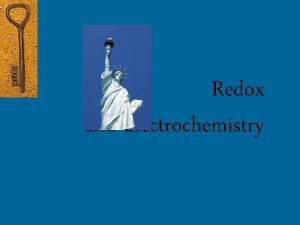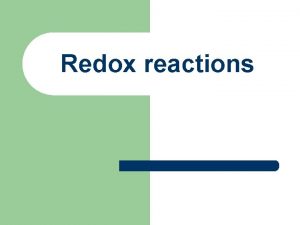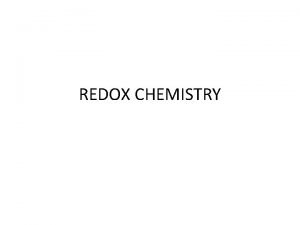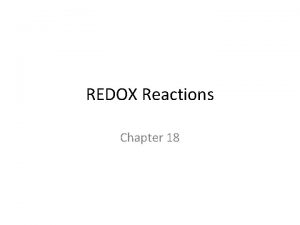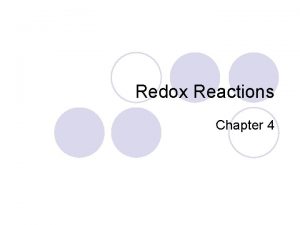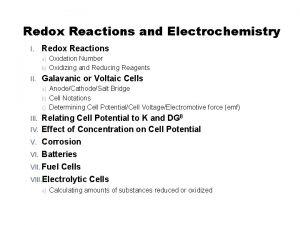Topic Redox Half reactions Do Now Quiz assign



















- Slides: 19

Topic: Redox – Half reactions Do Now: Quiz assign oxidation numbers

Now we know how to assign oxidation number…we can look at redox rxns • Haber Process – N 2(g) + 3 H 2(g) 2 NH 3(g) • Start by assigning oxidation numbers 0 0 -3 +1 • N 2(g) + 3 H 2(g) 2 NH 3(g) • What was oxidized? Reduced?

0 0 -3 +1 N 2(g) + 3 H 2(g) 2 NH 3(g) 4 • 3 • 2 1 • 0 -1 • -2 -3 • -4 • O • Oxidation I • Is L • Losing electrons N Began Ended 0 -3 Gained 3 electrons = Reduced R • Reduction I • Is H 0 +1 G • Gaining electrons Lost 1 electron = Oxidized

Why use the word “reduced” when electrons are gained? Electrons are Negative! Look how oxidation number changes Ex: Cl gains an electron → Cl-1 • oxidation # ↓ from 0 to -1; the # was reduced

Half Reactions • Even though oxidation & reduction reactions occur together we write separate equations for each process and include # of e- gained/lost – known as Half-Reactions

Half Reactions • Half-reactions must demonstrate: – conservation of mass & conservation of charge – # atoms on left must = # atoms on right – total charge on left must = total charge on right

0 0 -3 +1 N 2(g) + 3 H 2(g) 2 NH 3(g) • Oxidation = electrons lost OIL (becomes more positive) –So electrons are on the product side • H lost 1 electrons, but since its NH 3, there are 3 H so a total of 3 e- are lost But something +1 • H 2 H + 1 e is wrong! +1 1 and -1 equals 0 0 =

Remember… • H 2 H+1 + 1 e- • Total Charge on left = Total Charge on right • # atoms on left = # atoms on right • H 2 2 H+1 + 1 e • Something is still wrong! • Charge is off now • H 2 2 H+1 + 2 e- 2 x +1 = +2 and -2 equals 0

0 0 -3 +1 N 2(g) + 3 H 2(g) 2 NH 3(g) • Reduction = electrons gained RIG (becomes more negative) –So electrons are on the reactant side • Each N gained 3 electrons, but 2 N so –N 2 + 6 e- 2 N-3 0 + -6 = 2 X -3

Oxidizing Agent: Substance being reduced – Accepts electrons – aids oxidation for another species Nitrogen is the Oxidizing Agent Reducing Agent: Substance being oxidized – Loses electrons – aids reduction for another species Hydrogen is the Reducing Agent

You Try: • • 0 0 +2 -2 Mg + S Mg. S What is oxidized? What is reduced? Assign Oxidation Numbers Figure out change in oxidation numbers Mg: 0 to +2 = Oxidation S: 0 to -2 = Reduction

Now write the Half-Reactions 0 0 +2 -2 Mg + S Mg. S Mg is oxidized: S is reduced: Mg+2 + 2 e- S + 2 e- S-2

0 +1 -1 0 +2 -1 Zn + 2 HCl H 2 + Zn. Cl 2 What is oxidized? Reduced? • Zn goes from 0 to +2 = oxidation • H goes from +1 to 0 = reduction • Cl goes from -1 to -1; No change

0 +1 -1 0 +2 -1 Zn + 2 HCl H 2 + Zn. Cl 2 • Write Half Reactions Zn Zn+2 + 2 e 2 H+1 + 2 e- H 2

Taking it one step further

The steps… 1. 2. 3. 4. Assign oxidation numbers to all atoms in equation Determine elements changed oxidation number Identify element oxidized & element reduced Write half-reactions (diatomics must stay as is, everyone you can write with their oxidation number only – NH 3 = N-3 but Cl 2 stays Cl 2 not Cl) 5. Number electrons lost & gained must be equal; multiply half-reactions if necessary 6. Add half-reactions; Transfer coefficients to skeleton equation 7. Balance rest of equation by counting atoms

0 +1 +5 -2 +2 +5 -2 0 Cu + Ag. NO 3 Cu(NO 3)2 + Ag 1. Assign oxidation numbers to all atoms in equation 2. Determine elements changed oxidation number – Cu 0 +2 Ag +1 0 – N +5 unchanged O -2 unchanged 3. Identify element oxidized & element reduced – Oxidation (OIL) =Cu – Reduction (RIG) = Ag

0 +1 +5 -2 +2 +5 -2 0 Cu + Ag. NO 3 Cu(NO 3)2 + Ag 4. Write half-reactions – Cu Cu+2 + 2 e– Ag+1 + 1 e- Ag 5. Number electrons lost & gained must be equal; multiply halfreactions if necessary – 2(Ag+1 + 1 e- Ag) – 2 Ag+1 + 2 e- 2 Ag

0 +1 +5 -2 +2 +5 -2 0 Cu + Ag. NO 3 Cu(NO 3)2 + Ag 6. Add half-reactions; Transfer coefficients to skeleton equation Cu Cu+2 + 2 e+___________ 2 Ag+1 + 2 e- 2 Ag Cu + 2 Ag+1 + 2 e- 2 Ag + Cu+2 + 2 e. Cu + 2 Ag+1 2 Ag + Cu+2 Cu + 2 Ag. NO 3 Cu(NO 3)2 + 2 Ag 7. Balance rest of equation by counting atoms original reaction:
 Redox reaction
Redox reaction Oxidation number of no2-
Oxidation number of no2- Writing half reactions
Writing half reactions Is photosynthesis a redox reaction
Is photosynthesis a redox reaction Different types of redox reactions
Different types of redox reactions Reactions that produce gas
Reactions that produce gas Oxidation meaning in chemistry
Oxidation meaning in chemistry Concentration cell definition
Concentration cell definition Example of redox reaction
Example of redox reaction Chapter 19 redox reactions answers
Chapter 19 redox reactions answers Leo goes ger
Leo goes ger Balancing complex redox reactions
Balancing complex redox reactions Balancing redox reactions in acid
Balancing redox reactions in acid Balancing redox reactions
Balancing redox reactions Activity series oxidation
Activity series oxidation How do you balance a chemical equation
How do you balance a chemical equation Redox reactions ncea level 2
Redox reactions ncea level 2 Half equations worksheet with answers
Half equations worksheet with answers How redox reactions work
How redox reactions work Concept map redox reactions
Concept map redox reactions

